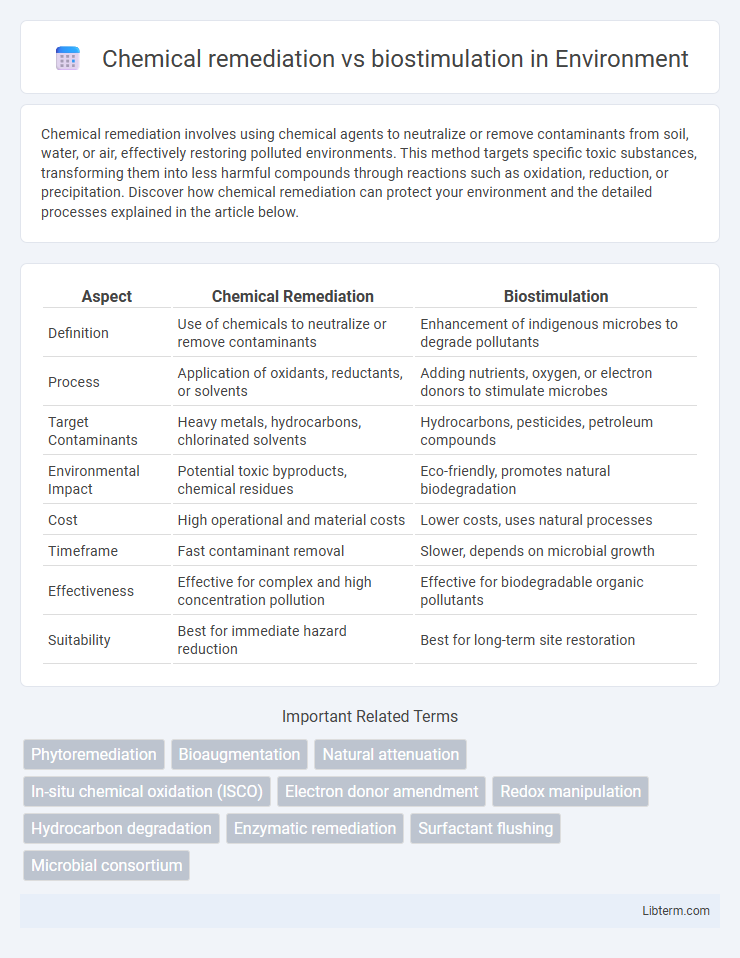Chemical remediation involves using chemical agents to neutralize or remove contaminants from soil, water, or air, effectively restoring polluted environments. This method targets specific toxic substances, transforming them into less harmful compounds through reactions such as oxidation, reduction, or precipitation. Discover how chemical remediation can protect your environment and the detailed processes explained in the article below.
Table of Comparison
| Aspect | Chemical Remediation | Biostimulation |
|---|---|---|
| Definition | Use of chemicals to neutralize or remove contaminants | Enhancement of indigenous microbes to degrade pollutants |
| Process | Application of oxidants, reductants, or solvents | Adding nutrients, oxygen, or electron donors to stimulate microbes |
| Target Contaminants | Heavy metals, hydrocarbons, chlorinated solvents | Hydrocarbons, pesticides, petroleum compounds |
| Environmental Impact | Potential toxic byproducts, chemical residues | Eco-friendly, promotes natural biodegradation |
| Cost | High operational and material costs | Lower costs, uses natural processes |
| Timeframe | Fast contaminant removal | Slower, depends on microbial growth |
| Effectiveness | Effective for complex and high concentration pollution | Effective for biodegradable organic pollutants |
| Suitability | Best for immediate hazard reduction | Best for long-term site restoration |
Introduction to Environmental Remediation
Chemical remediation employs reactive agents to neutralize or remove contaminants from soil or water, offering rapid and targeted cleanup. Biostimulation enhances the natural microbial activity by adding nutrients or substrates to accelerate the biodegradation of pollutants. Both methods are integral to environmental remediation, chosen based on contaminant type, site conditions, and desired cleanup goals.
Understanding Chemical Remediation
Chemical remediation involves using chemical agents such as oxidizers, reducers, or surfactants to degrade, stabilize, or remove contaminants from soil and groundwater. This method accelerates contaminant breakdown through direct chemical reactions, often targeting pollutants like chlorinated solvents and hydrocarbons. Understanding chemical remediation requires analyzing site-specific factors such as contaminant type, concentration, and geochemistry to design effective treatment strategies.
Overview of Biostimulation Techniques
Biostimulation techniques enhance the natural microbial degradation of contaminants by optimizing environmental conditions such as nutrient levels, pH, oxygen availability, and moisture content. Methods include nutrient amendment, oxygen delivery systems, and bioaugmentation to accelerate biodegradation in soil and groundwater. This approach contrasts with chemical remediation, which relies on chemical oxidants or reductants to directly neutralize pollutants, while biostimulation leverages native microbial communities for sustainable contaminant removal.
Key Differences Between Chemical Remediation and Biostimulation
Chemical remediation relies on the use of synthetic chemicals or reagents to neutralize or remove contaminants from soil or water, often providing rapid results but sometimes introducing secondary pollutants. Biostimulation enhances the natural microbial degradation process by adding nutrients or electron donors to stimulate indigenous bacteria, making it an eco-friendly approach suitable for organic pollutant breakdown over longer periods. Key differences include the speed of contaminant removal, the environmental impact, and the reliance on biological activity for contaminant degradation.
Mechanisms of Action: Chemical vs Biological Approaches
Chemical remediation relies on the direct application of oxidants or reductants to degrade contaminants through abiotic reactions, rapidly altering pollutant chemical structures. Biostimulation enhances indigenous microbial activity by supplying nutrients or electron donors, promoting biodegradation via enzymatic processes that transform pollutants biologically. While chemical methods offer immediate contaminant breakdown, biostimulation facilitates sustained, in situ degradation driven by microbial metabolic pathways.
Effectiveness in Treating Various Contaminants
Chemical remediation utilizes oxidizing or reducing agents to rapidly degrade a wide range of organic contaminants like hydrocarbons and chlorinated solvents, showing high effectiveness in cases requiring immediate pollutant breakdown. Biostimulation enhances indigenous microbial activity by adding nutrients or electron donors, proving highly effective for persistent pollutants such as petroleum hydrocarbons and certain chlorinated compounds through natural biodegradation processes. The choice between chemical remediation and biostimulation depends on contaminant type, site conditions, and desired remediation speed, with chemical methods offering swift contaminant reduction and biostimulation providing sustainable long-term treatment.
Environmental Impact and Sustainability Considerations
Chemical remediation often involves synthetic agents that may introduce secondary pollutants and disrupt local ecosystems, raising concerns about long-term environmental sustainability. Biostimulation enhances indigenous microbial activity using natural nutrients, promoting contaminant degradation with minimal ecological disturbance and improved ecosystem recovery. The sustainability advantage of biostimulation lies in its reliance on natural processes, reducing chemical inputs and supporting soil and groundwater health over time.
Cost Analysis and Resource Requirements
Chemical remediation often involves higher upfront costs due to the purchase of chemical agents and specialized equipment, with ongoing expenses for handling and disposing of hazardous materials. Biostimulation typically requires lower capital investment, relying primarily on nutrient amendments and microbial activity enhancement, which minimizes expensive chemical inputs but may extend remediation timelines. Resource requirements for chemical methods demand stringent safety protocols and skilled personnel, whereas biostimulation emphasizes monitoring microbial populations and environmental conditions to optimize natural degradation processes.
Case Studies: Real-World Applications
Chemical remediation methods in case studies often demonstrate rapid contaminant breakdown through oxidation or reduction reactions, effectively treating sites with high concentrations of industrial solvents or heavy metals. Biostimulation case studies highlight enhanced microbial activity by nutrient amendment, proving successful in degrading petroleum hydrocarbons in soil and groundwater over longer periods. Comparative analyses show biostimulation offers sustainable and cost-effective solutions with minimal environmental disturbance, while chemical remediation provides quicker results for acute pollution events.
Choosing the Right Remediation Approach
Choosing the right remediation approach depends on site-specific conditions such as contaminant type, concentration, and environmental impact. Chemical remediation offers rapid contaminant breakdown through oxidants or reductants but may pose risks of secondary pollution. Biostimulation enhances native microbial activity by adding nutrients or electron donors, promoting sustainable and cost-effective degradation of organic pollutants in situ.
Chemical remediation Infographic

 libterm.com
libterm.com